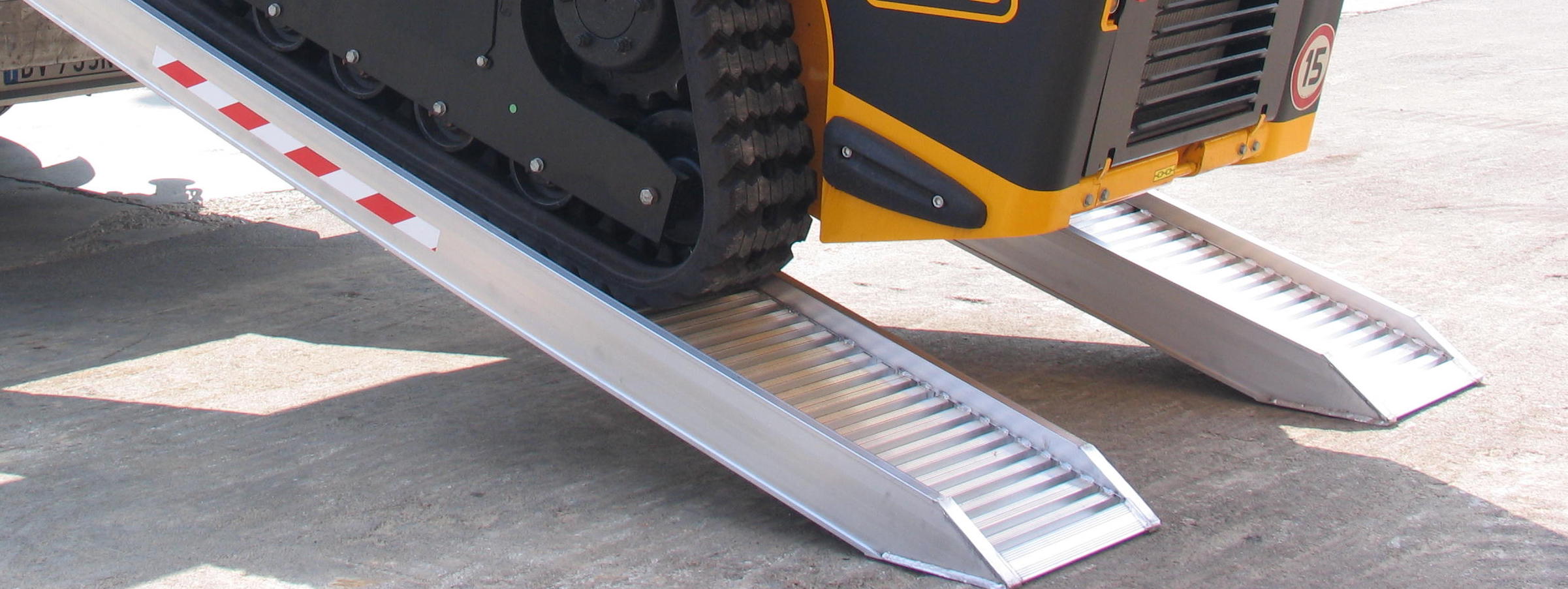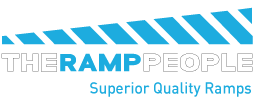
Ramps to safely load plant machinery
Buying a ramp for loading machinery (for example diggers, tractors, dumper trucks etc.) should not be taken lightly. Purchasing the wrong ramp can lead to the ramp breaking which in turn puts the user at risk and of course can damage the machinery. If you are not a ramp expert it can be hard to tell which type of ramp would meet your needs so we have put together a helpful guide.



 Weight of the ramps
We recommend you check the weight of the ramps you plan to purchase prior to ordering. It does depend on the ramp in question, and the person(s) abilities as to whether they will be light enough for you to use. Nylon straps can be provided on the ramps to assist with lifting. We generally recommend 4 straps per ramp, 8 straps per pair.
Custom Options
We can customise your ramps to meet your needs, please simply contact our team to discuss your needs. Built to order items generally have a 4-5 week lead time as they are built in our factory in Europe. The ramps will be TUV certified. Customisations include; cut for specific load heights, nylon grab handles, connection options, edges on ramps, additional support bars.
Weight of the ramps
We recommend you check the weight of the ramps you plan to purchase prior to ordering. It does depend on the ramp in question, and the person(s) abilities as to whether they will be light enough for you to use. Nylon straps can be provided on the ramps to assist with lifting. We generally recommend 4 straps per ramp, 8 straps per pair.
Custom Options
We can customise your ramps to meet your needs, please simply contact our team to discuss your needs. Built to order items generally have a 4-5 week lead time as they are built in our factory in Europe. The ramps will be TUV certified. Customisations include; cut for specific load heights, nylon grab handles, connection options, edges on ramps, additional support bars.
Key Factors
- Load height (from the ground to where the ramp will rest)
- What is the weight/capacity of the item you are loading?
- Does the machine have rubber or steel tracks?
- What connection type do you require?
- What is your wheelbase?
- What is your track width?
- Ground clearance of the vehicle you are loading
- How heavy are the ramps?
Load Height
This is the height from the ground to where the ramp will rest. The load height determines the length of ramp you need. EU guidelines recommend a maximum gradient of 1:3:3 or 30%. Some machinery does require a smoother gradient so we would suggest referring to your machines user manual to identify the maximum gradient it can operate at. Our aluminium loading ramps are are cut for a specific load height, taking into consideration the 30% gradient. If the ramps are used at the incorrect height, they will not sit correctly on the ground and the ramps will not longer be able to support the full capacity they are designed to hold.
Capacity
Prior to purchase, consider the maximum weight you wish to load on your ramps. This needs to include the machinery, any weight the machine is carry, fuel/fluids and the driver. maximum capacity you wish to load.Does the machine have rubber or steel tracks?
We have a range of ramps suitable for rubber and steel tracks. Our steel track ramps are provided with rubber coating or a milled surface.
What connection type do you require?
We have 4 connection options available (rest on, hook, bottom hook and tube). The most common connection option is the rest on connection which is designed for flat-beds and tipper trucks. This simply rests onto the vehicle, there is a predrilled hole in the ramp to allow you to secure the ramp to the vehicle with a pin. Alternative connection types are available at €50.00 + VAT.
Your wheelbase
To check your wheelbase, measure the distance from the centre of the drive wheel to the centre of the other drive wheel on the same track. As the wheelbase decreases, the capacity of the ramp also decreases.Your track width
All of our vehicle and plant ramps have a minimum track/wheel width stated to ensure the weight is evenly spread across the ramps. The vehicles tracks must remain at the centre of the ramp. As the capacity of the ramp increases, the minimum track width increases.Ground clearance of the vehicle you are loading
Machinery and vehicles with low ground clearance require longer ramps to ensure the vehicle can safely get up the ramp. We have various car ramps, forklift ramps and pallet truck ramps available which take lower ground clearance into consideration. We can also custom build a ramp with your vehicles clearance in mind. Please contact our team for advice on custom ramps. Weight of the ramps
We recommend you check the weight of the ramps you plan to purchase prior to ordering. It does depend on the ramp in question, and the person(s) abilities as to whether they will be light enough for you to use. Nylon straps can be provided on the ramps to assist with lifting. We generally recommend 4 straps per ramp, 8 straps per pair.
Custom Options
We can customise your ramps to meet your needs, please simply contact our team to discuss your needs. Built to order items generally have a 4-5 week lead time as they are built in our factory in Europe. The ramps will be TUV certified. Customisations include; cut for specific load heights, nylon grab handles, connection options, edges on ramps, additional support bars.
Weight of the ramps
We recommend you check the weight of the ramps you plan to purchase prior to ordering. It does depend on the ramp in question, and the person(s) abilities as to whether they will be light enough for you to use. Nylon straps can be provided on the ramps to assist with lifting. We generally recommend 4 straps per ramp, 8 straps per pair.
Custom Options
We can customise your ramps to meet your needs, please simply contact our team to discuss your needs. Built to order items generally have a 4-5 week lead time as they are built in our factory in Europe. The ramps will be TUV certified. Customisations include; cut for specific load heights, nylon grab handles, connection options, edges on ramps, additional support bars. 